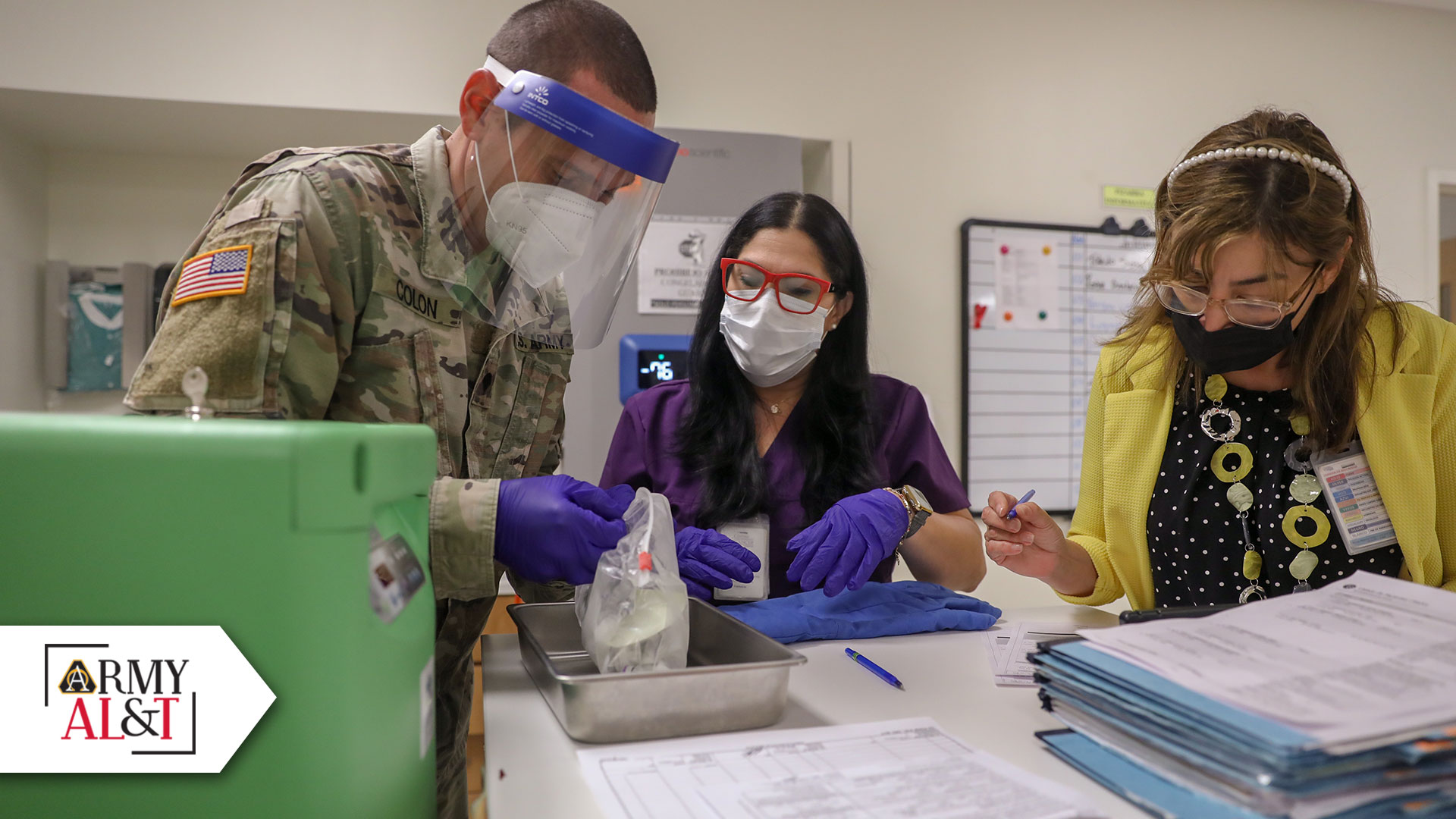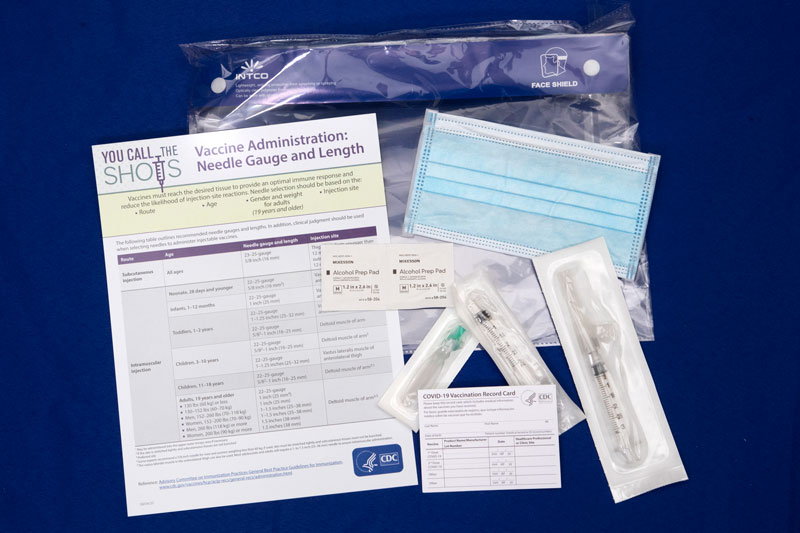
COUNT DAU IN: Spc. Juan Colón Otero helps count COVID-19 vaccines May 21 at the Comprehensive Cancer Research Center in Rio Piedras, Puerto Rico. DAU provided a fully embedded cross-functional team to support DOD during the COVID crisis. (U.S. Army National Guard photo by Spc. Hassani Ribera)
Defense Acquisition University has made drastic changes to its offerings in the face of COVID-19, to better support Army acquisition professionals around the world.
by Shannon Seay and Matthew Sablan
Along with the rest of the world, Defense Acquisition University (DAU) was hit with the full force of the COVID-19 pandemic in early 2020. As Fort Belvoir, Virginia, and the regional headquarters moved to virtual environments, DAU never lost sight that the Defense Acquisition Workforce was relying on faculty and staff to help them achieve their career milestones and deliver vital support to the warfighter.
THE MODERN LEARNING PLATFORM
“Nothing demonstrates that DAU [is the learning platform of the future] better than the instant responsiveness faculty and staff had when the pandemic forced us to close physical classrooms and convert all courses and support to virtual offerings,” said DAU President Jim Woolsey.
When the pandemic hit, many academic institutions and DOD organizations were left scrambling to modify practices and establish virtual environments. DAU, however, already had a significant online presence with its robust set of acquisition guides and tools, communities of practice, ACQuipedia, the Defense Acquisition Guidebook and more. “DAU is forward leaning and pushing the boundaries of what we can do with our technology, and we’ll continue to push those boundaries looking for continuous improvement,” said Tim Hamm, DAU’s chief information officer.
As a result of this presence, DAU was able to convert 99 of 126 classroom courses to online learning assets—approximately 85 percent of scheduled courses—within three weeks of closing physical campuses while faculty worked remotely. “We continued to deliver classes,” DAU professor Amy Timmermann said, “but we were delivering material that was not meant to be conveyed in this virtual forum. We had material designed for a traditional classroom learning to deliver that as we best saw fit.”
Beyond leveraging the virtual classroom, DAU launched several new learning opportunities. In total, it ensured that 23,000 students were able to continue their mission-critical learning by doubling the number of webcasts (more than triple the webcasts offered in fiscal year 2019). “We had to quickly scale up, and from a technology standpoint, we were lucky to have been staged to get everyone remote without any impact to their capabilities, out of the gate,” Hamm said.
Overall, DAU delivered 1 million hours of classroom training and 4.3 million hours of online training during fiscal year 2020. “We knew we still had to deliver quality,” Timmermann said. “It’s been all hands on deck.”
This increased operational tempo required staff to be collaborative and to maintain flexibility and adaptability in the face of the growing crisis. Timmermann explained that staff needed to do things in a way they had not previously done. Older course material that had not been developed for online or virtual means needed to be adapted, and students also had to adapt to the new environment.
DAU also generated new support and training assets informed by the realities created by COVID-19. While working through the early pandemic response, DAU provided U.S. Special Operations Command, Army Futures Command and Program Executive Office for Enterprise Information Systems targeted training using adaptive acquisition workshops. DAU also provided support to the Army Medical Research and Development Command via a series of workshops to establish and build relationships with new stakeholders as part of the command’s realignment. Writing workshops also expanded under COVID-19, with the Professional Writing Workshop moving to a virtual environment to accommodate 220 learners from the F-35 Joint Program Office, shifting from quarterly offerings to six weekly courses to meet the new demand.
FEDERAL RESPONSE TO COVID-19 PANDEMIC
DAU faculty provided assisted acquisition support to Operation Warp Speed, now known as the Countermeasures Acceleration Group, and the Office of the Undersecretary of Defense for Acquisition and Sustainment’s Joint Rapid Acquisition Cell. DAU faculty were embedded within the Joint Program Executive Office for Chemical, Biological, Radiological and Nuclear Defense’s (JPEO-CBRND) Joint Assisted Acquisition (JA2) team to provide program management, logistics and contracting expertise. The DAU team worked within JPEO-CBRND to support Department of Health and Human Services (HHS) requirements to expedite the acquisitions for COVID-19 vaccines, therapeutics, enablers (syringes, needles, vials and swabs) and to expand domestic manufacturing to ensure the nation has a robust supply chain for medical countermeasures to battle future pandemics.
DAU provided virtual support in two phases. The first was supporting JPEO-CBRND in leading a broad range of rapid assisted acquisition efforts in support of the interagency COVID-19 response—one of the largest DOD efforts in 2020. As the pandemic wore on, HHS identified requirements to support the urgent response as well as longer-term preparedness and resilience. In March, JPEO-CBRND requested further DAU assistance, and a new set of faculty experts was rapidly integrated into the JA2 team to address the emerging needs of the second phase.
JPEO-CBRND and Army Contracting Command used existing authorities and innovative contacting approaches to accelerate access to nontraditional defense contracting for the federal COVID-19 response. “Within the JPEO, we quickly evaluated and leveraged the best acquisition strategy to accelerate the U.S. government’s ongoing COVID-19 response and pandemic preparedness,” said Gary Wright, the assistant joint program executive officer for assisted acquisition.
As part of this partnership, DAU was operating under a support agreement with JPEO-CBRND. Under the leadership of the U.S. Army, DAU was providing direct support as cross-functional subject matter experts.
As staff augmentees, DAU provided critical bridge support to the JPEO-CBRND and partner DOD agencies as their Assisted Acquisition team transitioned to a more enduring capability. These actions continue to solidify DAU’s role in the DOD acquisition community and may help define new ways DAU can support DOD in the future.
In partnering with the JPEO-CBRND, DAU gained valuable insights on the current climate for rapid acquisitions and the training needs of today’s acquisition workforce. This will allow DAU to infuse new topics and continue to improve existing learning assets. A great example was the recent successful award of a $3.5 billion procurement and distribution contract within 37 days, to meet the presidential requirement to provide half a billion Pfizer vaccines to low-income nations around the world. The DAU team was instrumental to the accomplishment by supporting an interagency team under a new requirement owner, the U.S. Agency for International Development.
DAU demonstrated flexibility in mission assistance by providing a fully embedded cross-functional team to support DOD during a national crisis. A typical embed mission assistance provides subject matter expertise support and consulting to a DOD acquisition program. This mission assistance is one of the many ways that DAU is changing its approach to supporting DOD. The team was not only able to get contracts awarded for vaccine activities, it also established repeatable processes for rapid acquisition and trained incoming personnel, ensuring JPEO-CBRND’s excellence in execution will endure.

READY FOR DELIVERY: Items that were provided with COVID-19 vaccines at Operation Warp Speed headquarters in Washington on Nov. 13, 2020. DAU generated new support and training assets to help battle COVID-19. (Photo by EJ Hersom, Defense.gov)
AFTERMATH
“Everyone came together to find out what we needed to change, and we all did our part,” Timmermann said. “We spent time every week delivering information on what courses were now available, what was canceled and—looking at the numbers—DAU excelled.”
“Back then, a lot of student feedback was ‘thank yous’ for getting them the classes they needed,” Timmermann said of the early period of COVID. “DAU is working to become a frictionless, user-friendly and adaptable platform. The faculty is willing to change and adapt to this new environment, and I think this willingness to transform ourselves leads to less friction for students.”
During 2020 and 2021, DAU has continued to expand virtual instructor-led training support and support staff. DAU’s expanded technology capabilities have also been used for events, webinars and even DAU’s flagship event of 2021—TEDxDAU Platforms of the Future—to a virtual-only audience of approximately 3,600.
“The technology and support piece has been critical to our success,” Hamm said. “We’re continuing to scale up our support and implement technology that can be accessed from anywhere to deliver more than just training. We didn’t let it slow our work down at all.”
Because of these successes, DAU is not going to go back to how things were before. Hamm highlighted several of the advancements, including the permanent shift from a .mil to a .edu website and expanding remote work solutions, as examples of how DAU’s focus on virtual learning is already helping customers and students.
“We’ve built this new reality into our work processes and leveraged our skilled staff to keep things running,” he said. “We did these things faster, in part thanks to the great support we received from Washington Headquarters Services. Getting licenses, hardware and awarding the work helped remove any barriers that we might have had to our success.”
CONCLUSION
DAU’s continued expansion of online learning has demonstrated DAU can deliver quality learning in the virtual environment at scale. DAU will continue to increase flexibility and expand digital offerings, while ensuring the workforce can complete the training with less time away from their jobs and families.
For more information about DAU’s COVID-19 response and other achievements, refer to the 2020 DAU Annual Report at https://go.usa.gov/xeqBT.
SHANON SEAY is a DAU professor of acquisition and program management. He holds an M.S. in management of information systems from Florida Institute of Technology and a B.S. in industrial design from Auburn University. He is Level III certified in program management.
MATTHEW SABLAN supports the DAU communications team. He has a B.A. in history and English from Marymount University and previously wrote for the Defense Contract Management Agency and the U.S. Army Combat Capabilities Development Command Ground Vehicle Systems Center (formerly the Tank and Automotive Research and Development Center).







